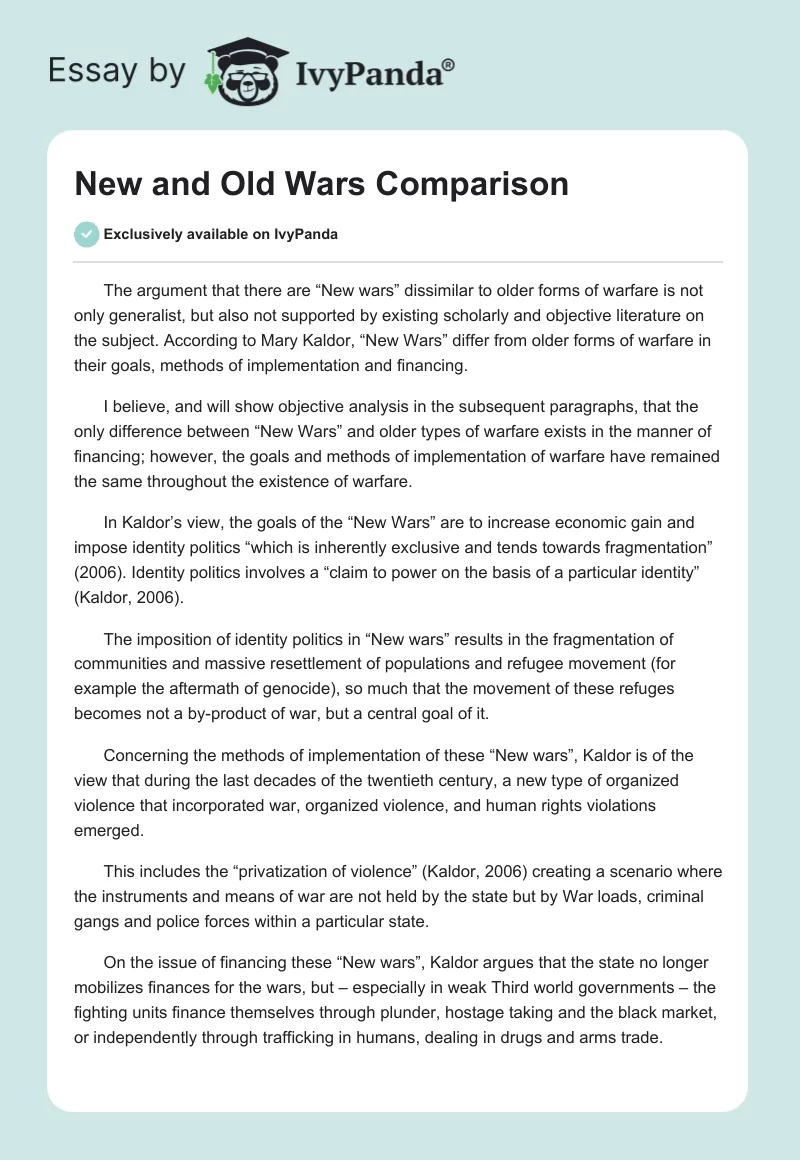The argument that there are “New wars” dissimilar to older forms of warfare is not only generalist, but also not supported by existing scholarly and objective literature on the subject. According to Mary Kaldor, “New Wars” differ from older forms of warfare in their goals, methods of implementation and financing.
I believe, and will show objective analysis in the subsequent paragraphs, that the only difference between “New Wars” and older types of warfare exists in the manner of financing; however, the goals and methods of implementation of warfare have remained the same throughout the existence of warfare.
In Kaldor’s view, the goals of the “New Wars” are to increase economic gain and impose identity politics “which is inherently exclusive and tends towards fragmentation” (2006). Identity politics involves a “claim to power on the basis of a particular identity” (Kaldor, 2006).
The imposition of identity politics in “New wars” results in the fragmentation of communities and massive resettlement of populations and refugee movement (for example the aftermath of genocide), so much that the movement of these refuges becomes not a by-product of war, but a central goal of it.
Concerning the methods of implementation of these “New wars”, Kaldor is of the view that during the last decades of the twentieth century, a new type of organized violence that incorporated war, organized violence, and human rights violations emerged.
This includes the “privatization of violence” (Kaldor, 2006) creating a scenario where the instruments and means of war are not held by the state but by War loads, criminal gangs and police forces within a particular state.
On the issue of financing these “New wars”, Kaldor argues that the state no longer mobilizes finances for the wars, but – especially in weak Third world governments – the fighting units finance themselves through plunder, hostage taking and the black market, or independently through trafficking in humans, dealing in drugs and arms trade.
On this matter, as stated in the introduction, I concur with Kaldor’s argument that the only difference between “New wars” and older types is in the modality of financing.
To counter kaldor’s theory concerning the goals and implementation methods of the “New wars”, the first counter-argument concerns the matter of goals of the war. Economic gain has always been the paramount objective of wars, and is not a feature exclusive to “New wars”.
More scrutiny and analysis of wars in contemporary times by “academics, policy analysts, and politicians” (Newman, 2004, p.180) has served to highlight the wars, bringing out deeper dynamics of the wars, but the main objectives like economic gain have always been present.
Even the contemporary factor of multinationals selling weapons to the warring parties serves the same purpose – profiting from war. Furthermore, Identity politics and wars based on fragmenting the society along the lines of race, ethnicity, and religion are as old as war itself.
The Armenian genocide of World War I and the Holocaust of World War II are prime examples. The Rwandan genocide of 1994, a supposed “New War”, has similar features with the two previous genocides, which according to Kaldor, are old types of warfare.
In conclusion, I have presented Kaldor’s “New Wars” theory, identifying its goals, methods and financing. I have argued against its goals and methods, focusing on the argument that both goals and methods can be found throughout history in older forms of warfare.
Various violent conflicts, from the present and past, have been addressed and an analysis of the Rwandan genocide, the holocaust, and the Armenian genocide posed. Moreover, the role of the media and advances in information has been analyzed to show that just because there is much more analysis and discussion about wars nowadays does not necessarily make them ‘new’.
References
Kaldor, M. (2006). New and Old Wars, 2nd ed. Cambridge: Polity.
Newman, E. (2004). The ‘New Wars’ debate: A historical perspective is needed. Security Dialogue vol. 35(2) 173-189.


